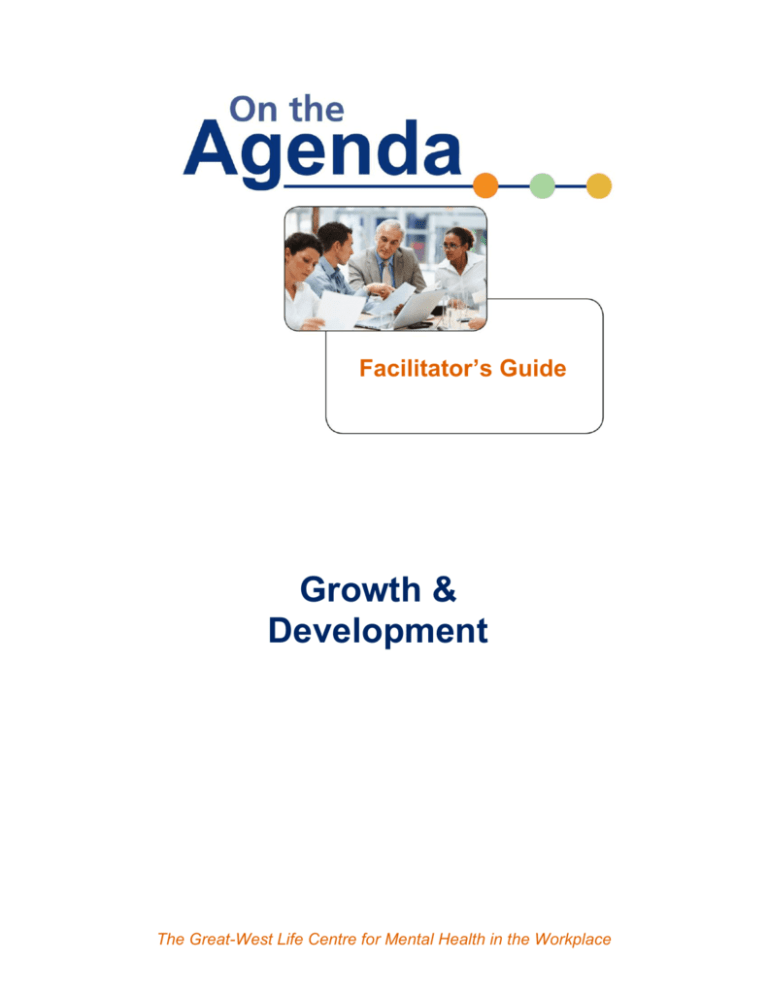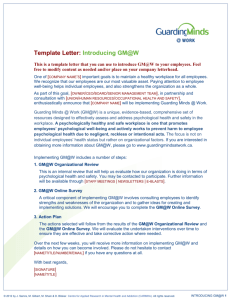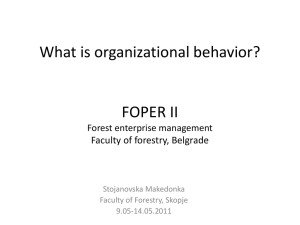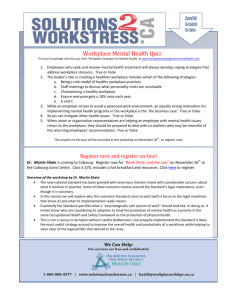
Facilitator’s Guide
Growth &
Development
The Great-West Life Centre for Mental Health in the Workplace
Growth & Development
Slide # 1
For this slide, you want to ensure that you have already introduced:
yourself
your role within the organization, if unknown to the group
why you are engaging the group in this discussion
the importance of addressing psychological health and safety in your organization
The importance of addressing psychological health and safety in your organization can be
highlighted by stating the following:
1. Depression will rank second only to heart disease as the leading cause of
disability worldwide by the year 2020, which can impact the workplace in areas
such as bottom-line production and team work.
2. There are current and emerging legal requirements in Canada for the protection
of employee psychological health and safety and the promotion of civility and
respect at work.
3. Organizations that value and improve the health of the workplace can improve
their organization profile. An improved profile can result in better recruitment and
retention rates, enhancing the potential for growth. We want you and potential
employees to know that we value your contribution to the organization, that you
do good work and that we want to help you to continue to be successful at work.
After these statements, you might say: “The focus of this session is to discuss employee
growth and development in the workplace”.
On the Agenda
The Great-West Life Centre for Mental Health in the Workplace
2
Growth & Development
Slide # 2
This slide provides a definition of employee growth and development. We recommend
starting with the definition provided by Guarding Minds @ Work™: “Growth and development
occur in a work environment where employees receive encouragement and support in the
development of their interpersonal, emotional and job skills.” Then open the floor for
questions about the definition. An idea to get employees to start participating in your
presentation is to ask a volunteer in the audience to read the slide. You can also offer
additional information such as:
1. What does growth and development in the workplace mean?
Possible Answer: They mean the workplace provides a range of opportunities for
employees to build their skills to help with their current jobs and prepare for possible
future positions.
2. Why are growth and development important?
Possible Answer: They allow for greater goal commitment on behalf of employees
because employees feel supported in their future aspirations.
On the Agenda
The Great-West Life Centre for Mental Health in the Workplace
3
About PF6: Growth & Development
What are Psychosocial Factors?
Psychosocial factors are elements that impact employees’ psychological responses to work and work conditions, potentially
causing psychological health problems. Psychosocial factors include the way work is carried out (deadlines, workload, work
methods) and the context in which work occurs (including relationships and interactions with managers and supervisors,
colleagues and coworkers, and clients or customers).
What is PF6: Growth & Development?
GM@W defines PF6: Growth & Development as present in a work environment where employees receive encouragement and
support in the development of their interpersonal, emotional and job skills. Such workplaces provide a range of internal and
external opportunities for employees to build their repertoire of competencies, which will not only help with their current jobs, but
will also prepare them for possible future positions.
Why is Growth & Development important?
Employee development increases goal commitment, organizational commitment and job satisfaction. Employees feel that
organizations care when they support growth and development, and skill acquisition and career development directly
enhance employee well-being. It is important to ensure that growth opportunities extend beyond learning specific technical
skills necessary for job performance, also including opportunities to learn personal and interpersonal skills that are critical to
successfully caring for oneself and relating to others.
What happens when employees don’t have opportunities for growth and development?
Employees who are not challenged by their work will grow bored, their well-being will suffer, and their performance will drop.
When staff do not have opportunities to learn and improve their interpersonal and psychological skills, the result can be
conflict, disengagement and distress.
How can Growth & Development be improved?
Start by conducting the GM@W Organizational Review and/or the GM@W Survey and reviewing the results. If Growth &
Development is identified as an area of concern or relative strength, refer to the GM@W Action Resources for a practical
strategy and evidence-based and effective suggested actions that can improve Growth & Development. It is also important
to discuss the findings with employees to gain a further understanding of the results and to obtain input into possible
interventions. Furthermore, it is important to evaluate the undertaken interventions over time to ensure they are effective and
to take corrective action where needed. Consider reviewing the resources below. Finally, refer back to the GM@W website on
occasion for new ideas about how Growth & Development can be enhanced.
© 2012 by J. Samra, M. Gilbert, M. Shain & D. Bilsker.
Centre for Applied Research in Mental Health and Addiction (CARMHA). All rights reserved.
ABOUT PF6: GROWTH & DEVELOPMENT 1
Further information about Growth & Development:
• Briscoe, D. (1987). The 10 commandments of development. Training & Development Journal, 41(8), 54.
• Gilbert, M. & Bilsker, D. (2012). Psychological Health and Safety: An Action Guide for Employers. Retrieved from http://www.mentalhealthcommission.ca/SiteCollectionDocuments/Workforce/Workforce_Employers_Guide_ENG.pdf
• Jacobs, R., & Washington, C. (2003). Employee development and organizational performance: A review of literature and
directions for future research. Human Resource Development International, 6(3), 343-354. doi: http://dx.doi.org/10.1080/13678860110096211
• Lee, C., & Bruvold, N. (2003). Creating value for employees: Investment in employee development. International Journal
of Human Resource Management, 14(6), 981-1000. Retrieved from http://www.mobilityagenda.org/value.pdf
• Putrich, D. (2005). Employee development on a shoestring. Computerworld, 39(27), 32.
• The Great-West Life Assurance Company. (2012). PF6: Growth and Development. In Centre Resources by GM@W Factor
and On the Agenda. Retrieved from http://www.workplacestrategiesformentalhealth.com
www.guardingmindsatwork.ca
© 2012 by J. Samra, M. Gilbert, M. Shain & D. Bilsker.
Centre for Applied Research in Mental Health and Addiction (CARMHA). All rights reserved.
ABOUT PF6: GROWTH & DEVELOPMENT 2
Growth & Development
Slide # 3
This slide details what employee growth and development might look like. Simply read the
points on the slide. If you would like to expand on the information, we suggest elaborating on
what a non-supportive employee growth and development workplace may look like.
You can suggest the following and why you don’t want this for your group:
Employees do not feel challenged and can begin to feel bored
Performance will drop
Increased co-worker conflict
On the Agenda
The Great-West Life Centre for Mental Health in the Workplace
4
Growth & Development
Slide # 4
If your workplace completed the Guarding Minds @ Work (GM@W) Survey, you may wish to
review the scores now. Let your employees know that there is always room for improvement,
and it is also important to recognize and retain what is already working.
Review the suggestions on the slide and let them know that putting psychological
health and safety on the agenda is an active step to support employee growth and
development in the workplace.
If your workplace has not undertaken the GM@W Review or Survey, ask the
employees if they feel the suggestions on the slide would be helpful, and why or why
not.
On the Agenda
The Great-West Life Centre for Mental Health in the Workplace
5
GM@W Suggested Responses
Please consult the Selection of GM@W Suggested Actions and Selection of Effective Actions: Applying a Quality
Framework documents to help you select GM@W suggested actions to undertake for Growth & Development.
PF6: GROWTH & DEVELOPMENT
OBJECTIVE: A work environment where employees receive encouragement and support in the
development of their interpersonal, emotional and job skills.
PF6: GM@W Survey Results
(check rating, if applicable)
PF6: GM@W Organizational Review Results
(check rating, if applicable)
SERIOUS
CONCERNS
SIGNIFICANT
CONCERNS
MINIMAL
CONCERNS
RELATIVE
STRENGTHS
SERIOUS
CONCERNS
SIGNIFICANT
CONCERNS
MINIMAL
CONCERNS
RELATIVE
STRENGTHS
Serious Concerns = 5 to 9 Significant Concerns = 10 to 13 Minimal Concerns* = 14 to 16 Relative Strengths** = 17 to 20
* Although this is a Minimal Concern, it is important to attend to it and review the GM@W Organizational Review Results and
the GM@W Survey Results for any additional or individual-identified areas of concern.
** Although this is a Relative Strength, it is important to review the GM@W Organizational Review Results and the GM@W
Survey Results for any additional or individual-identified areas of concern.
© 2012 by J. Samra, M. Gilbert, M. Shain & D. Bilsker.
Centre for Applied Research in Mental Health and Addiction (CARMHA). All rights reserved.
GM@W SUGGESTED RESPONSES PF6: GROWTH & DEVELOPMENT 1
The list below contains actions that you can take to respond to actual or potential concerns related to Growth &
Development. Many of these actions have been found to be effective in research studies, have been recommended as best
practices, or have been found valuable in applied settings. Some have been informed by emerging case law and regulatory
requirements. The actions are drawn from diverse industries and sectors, and not all may be applicable or feasible in your
particular workplace. This list is not exhaustive, nor is it intended to be prescriptive. Rather, these are suggestions for possible
courses of action. If Growth & Development has been flagged as a Relative Strength in your workplace, it is important not to overlook this
finding. You can do this by developing policies that protect this relative strength and engaging staff in discussions of how this
strength can be enhanced by implementing the suggested actions below.
If Growth & Development has been flagged as an area of concern in your workplace, consider which of these actions
might be appropriate. In making your decision, it can be helpful to keep the following six key quality dimensions in mind:
Appropriateness, Acceptability, Accessibility, Effectiveness, Efficiency and Safety (see Selection of Effective Actions: Applying a
Quality Framework for more information).
The actions below fall into four main categories: (1) norms, values and practices of the work environment; (2) training and
development initiatives; (3) communication strategies and approaches; and (4) formal policies and programs. You may
have already initiated some of the actions – but consider the others. You may also have other ideas for actions you could
implement – there is a space for writing these down at the end of this document. Remember, not every action that might
enhance Growth & Development in your workplace is listed here. Implementing the following actions, however, will
provide a strong foundation for building a psychologically healthy and safe workplace.
© 2012 by J. Samra, M. Gilbert, M. Shain & D. Bilsker.
Centre for Applied Research in Mental Health and Addiction (CARMHA). All rights reserved.
GM@W SUGGESTED RESPONSES PF6: GROWTH & DEVELOPMENT 2
Work Environment (Norms, Values & Practices)
q Foster a culture where the development of interpersonal/emotional competencies is valued and encouraged
(Note: “interpersonal/emotional competencies” refer to abilities and capacities to manage emotions and
relationships, and to effectively solve challenging interpersonal problems at work)
q Emphasize the importance of “people skills” for all employees, but particularly for those in leadership roles
q Provide a range of resources and opportunities to enhance interpersonal/emotional competencies (e.g., on-site
library, intranet)
Training & Development
q Obtain staff input regarding the training they need to enhance their interpersonal/emotional growth and
development
q Provide opportunities for job-shadowing, job-sharing or mentoring that facilitate interpersonal/emotional skill
development
q Provide dedicated time and funds for training that includes a focus on developing employees’ interpersonal/
emotional skills
Communication
q Provide organizational acknowledgement and reinforcement for staff who have demonstrated exemplary
interpersonal/emotional behaviour throughout the course of their work
q Ensure that supervisors/leaders provide frequent and constructive feedback on employee performance and offer
opportunities and support for further interpersonal/emotional skill development
q Widely communicate internal and external opportunities for interpersonal/emotional growth and development
Formal Policies & Programs
q Create and maintain detailed development plans for employees that include goals for interpersonal/emotional skill
development, and review these in performance evaluations
q Provide opportunities for staff to develop skills that make them competitive for internal career postings
q Consider the interpersonal/emotional competencies of candidates in promotion decisions
Additional resources have been created to help you take action, including: presentation slides and supporting materials (freely
available at www.workplacestrategiesformentalhealth.com/ota) and a new resource - Psychological Health and Safety: An
Action Guide for Employers, developed on behalf of the Mental Health Commission of Canada Workforce Advisory Committee,
that is a practical tool designed to help employers develop implementation plans on the basis of GM@W findings (freely
available at www.mentalhealthcommission.ca/SiteCollectionDocuments/Workforce/Workforce_Employers_Guide_ENG.pdf).
We encourage you to review these resources for additional suggested actions.
© 2012 by J. Samra, M. Gilbert, M. Shain & D. Bilsker.
Centre for Applied Research in Mental Health and Addiction (CARMHA). All rights reserved.
GM@W SUGGESTED RESPONSES PF6: GROWTH & DEVELOPMENT 3
Other Actions:
q_____________________________________________________________________________________
_____________________________________________________________________________________
_____________________________________________________________________________________
_____________________________________________________________________________________
q_____________________________________________________________________________________
_____________________________________________________________________________________
_____________________________________________________________________________________
_____________________________________________________________________________________
q_____________________________________________________________________________________
_____________________________________________________________________________________
_____________________________________________________________________________________
_____________________________________________________________________________________
There won’t be a perfect set of actions – often it’s a matter of choosing the actions most likely to accomplish
positive outcomes while generating the fewest potential problems.
Once you have selected one or more actions to undertake, enter them into the corresponding GM@W Action
Planning Worksheet, pick your start date, identify who will be involved – your Action Team, and get started!
© 2012 by J. Samra, M. Gilbert, M. Shain & D. Bilsker.
Centre for Applied Research in Mental Health and Addiction (CARMHA). All rights reserved.
GM@W SUGGESTED RESPONSES PF6: GROWTH & DEVELOPMENT 4
Growth & Development
Slide # 5
Review the recommended actions in the GM@W Suggested Responses document
or choose those that you wish to share with the group as possibilities.
Ask the employees to work in groups of three or more to discuss what each of these
may mean for your workplace in regards to practicality, profit, cost and challenges.
Ask that someone keep notes, and let them know that their group is to report back to
the larger group in 15 minutes.
Ask for a group to volunteer to start the report back and begin the discussion to
choose which initiative(s) to begin with. .
Check out the Centre website at www.workplacestrategiesformentalhealth.com for
free resources related to growth and development.
On the Agenda
The Great-West Life Centre for Mental Health in the Workplace
6
Growth & Development
Slide # 6
Ask the employees to vote on the most important recommendation that they heard
from the previous exercise. Ballots, Post-it Notes, stickers or raised hands are all
ideas that could be used for voting.
If there is a discrepancy, see if you can narrow the options down to two and discuss
the potential pros and cons of each option and then re-vote, or consider
implementing more than one option at once if this would be practical.
Develop a statement with the group about why the chosen recommendation is
important to them; get to the underlying need that is being met.
On the Agenda
The Great-West Life Centre for Mental Health in the Workplace
7
Growth & Development
Slide # 7
Hand out the Action Planning Worksheet to each employee so he or she can follow
along.
Identify each step required to implement the chosen action(s).
Review the steps for implementing the various actions and ask for volunteers to take
on different actions. If individuals feel uncomfortable taking on an action by
themselves, suggest working in pairs or groups.
Set a follow-up date to review progress on the action items together, as well as an
expected completion date.
On the Agenda
The Great-West Life Centre for Mental Health in the Workplace
8
GM@W Action Planning Worksheet
Name:___________________________________________
Position: ________________________ Date: ____/____/____
PF6: GROWTH & DEVELOPMENT
OBJECTIVE: A work environment where employees receive encouragement and support in the development
of their interpersonal, emotional and job skills.
PF6 GM@W Survey Results
PF6 GM@W Survey Score: ________ (5 to 20)
SERIOUS CONCERNS
SIGNIFICANT CONCERNS
Date administered: ____/____/____
MINIMAL CONCERNS
RELATIVE STRENGTHS
PF6 GM@W Organizational Review Results
PF6 GM@W Organizational Review Score: ________ (5 to 20)
SERIOUS CONCERNS
SIGNIFICANT CONCERNS
Date administered: ____/____/____
MINIMAL CONCERNS
RELATIVE STRENGTHS
Serious Concerns = 5 to 9 Significant Concerns = 10 to 13 Minimal Concerns* = 14 to 16 Relative Strengths** = 17 to 20
* Although this is a Minimal Concern, it is important to attend to it and review the GM@W Organizational Review Results and
the GM@W Survey Results for any additional or individual-identified areas of concern.
** Although this is a Relative Strength, it is important to review the GM@W Organizational Review Results and the GM@W
Survey Results for any additional or individual-identified areas of concern.
© 2012 by J. Samra, M. Gilbert, M. Shain & D. Bilsker.
Centre for Applied Research in Mental Health and Addiction (CARMHA). All rights reserved.
GM@W ACTION PLANNING WORKSHEET PF6: GROWTH & DEVELOPMENT 1
© 2012 by J. Samra, M. Gilbert, M. Shain & D. Bilsker.
Centre for Applied Research in Mental Health and Addiction (CARMHA). All rights reserved.
GM@W ACTION PLANNING WORKSHEET PF6: GROWTH & DEVELOPMENT 2
Action Priority 3:
Action Priority 2:
Action Priority 1:
Starting Date
(What is a realistic date
to begin?)
Selected Action(s)
(What exactly are you
planning to do?)
End Date
(Is the action ongoing or
will it end? If so, when?)
Action Team
(Who is involved?
Be specific.)
Indicator(s)
(What changes do you expect to
result from this Action?)
Evaluation Date
(When will you determine if
the Action was successful?)
Growth & Development
Slide # 8
For this slide, we suggest encouraging your employees to check out the Workplace
Strategies for Mental Health website at www.workplacestrategiesformentalhealth.com. The
website features a number of employee-specific resources they can access for free:
Self-assessment tools to check their current state of mental health
Information about mental health, addiction and mental illness
Approaches to mental wellness and coping with workplace stressors
Working Through It, which is a video-based series of video clips by, and for, those
struggling while at work, off work or returning to work
On the Agenda
The Great-West Life Centre for Mental Health in the Workplace
9










